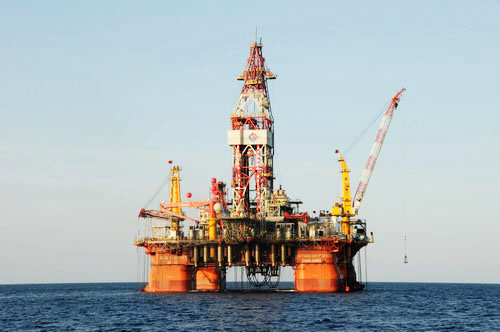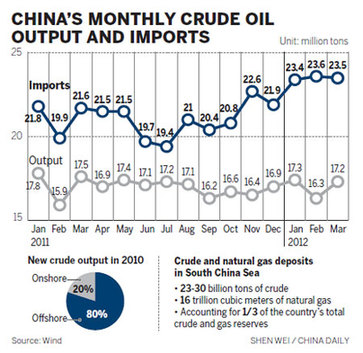
The first deepwater drilling rig developed in China is scheduled to drill a well in a part of the sea known as 43/11 block this year at a water depth of 2,454 meters, making it the deepest well in the South China Sea.
The block is being explored by China National Offshore Oil Corp, BP Plc and Anadarko Petroleum Corp. It is on a short list of sites where CNOOC, the owner of the rig, is considering using semi-submersible deepwater rig this year to drill wells.
On Wednesday, the rig began drilling its first well in an area 320 km southeast of Hong Kong and at a water depth of 1,500 meters.
The 5.3-billion-yuan ($839.9 million) rig is to drill the well for 56 days before being towed to other drilling sites in the Baiyun Depression, which encompasses 20,000 square kilometers in the eastern part of the South China Sea, said Shi Hesheng, the chief geologist of CNOOC (CHINA) Ltd Shenzhen Branch.
|
 The Haiyangshiyou 981 semi-submersible deepwater rig, developed and built by China State Shipbuilding Corp, goes into service in the South China Sea on Wednesday. The rig can drill to depths of about 10,000 meters. [Photo/China Daily] |
The Baiyun Depression contains about 700 million metric tons of crude oil and 1.2 trillion cubic meters of gas, Shi said.
The company said the progress of work at each of the proposed wells will largely determine how the drilling rig is used. In general, the equipment can drill about five to six wells a year, according to Zhou Shouwei, former deputy general manager of CNOOC.
China, as the world's second-largest oil consumer, used 470 million tons of oil in 2011. It has accelerated its pace of exploring for oil and gas in deepwater areas in the South China Sea, which is estimated to contain up to 30 billion tons of oil and 16 trillion cubic meters of gas, or a third of the country's oil and gas resources.
|
 |
Technological restrictions have hindered CNOOC from making rapid forays into deepwater drilling, which is riskier and costlier than exploring in shallow waters.
Generally speaking, the cost of drilling a deepwater well is about $30 million to $60 million, about five times higher than drilling in shallow waters, according to CNOOC, which said that it will need from 25 to 30 years to break even on the rig's cost.
The 137-meter-high drilling platform, which was completed last year after undergoing six years of construction, was tested for three months at a depth of about 750 meters in waters southeast of Haikou city, Hainan province, before being used for actual drilling, according to Jin Xiaojian, general manager of CNOOC's engineering department.
The block where it is drilling, which contains the Liwan 6-1-1 well, is estimated to have 30 billion cu m of gas reserves, equal to the amount contained in a mega gas field, Shi said.
China has yet to commercially produce oil and gas in domestic deepwaters.
CNOOC said the country may be capable of mass production next year in the Liwan 3-1 gas field, which is part of the South China Sea's 29/26 block in the Pearl River Mouth Basin. The field could have an annual output of "several billion" cubic meters of gas.
Liwan 3-1 was discovered by the Canadian oil giant Husky Energy Inc in 2006, the first discovery of deepwater resources in Chinese waters. The find demonstrated the potential for finding oil and gas in the country's deepwater area.
Another two natural gas fields in the same area - Liuhua 34-2 and Liuhua 29-1 - are expected to be brought into commercial production in 2014, CNOOC said.
"We will move forward in deepwater through our independent exploration as well as through cooperation with foreign companies," said Wang Yilin, CNOOC chairman.
zhouyan@chinadaily.com.cn